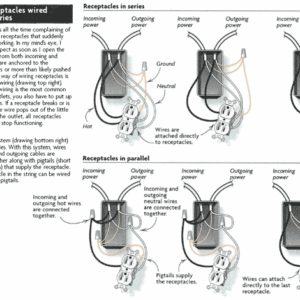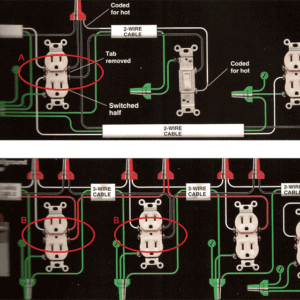I understand that there are two ways to wire up receptacles: either in series or in parallel. To wire in series one connects the live and neutral wires directly to the receptacles; to wire in parallel one connects the live and natural wires to the receptacle by a pigtail (see image 1 below).
<!—-><!—-> <!—->
Right so far?
<!—-> <!—->
Then I look at B&D’s “The Complete Guide to Home Wiring†and they have two additional wiring styles: A) the live wires are connect by pigtail but the neutral wires are connected directly, B) the neutral wires are connect by pigtail but the live wires are connected directly (see image 2 below).
<!—-> <!—->
My Questions:
- So are A&B in series or parallel?
- When should I wire receptacles in parallel and when is series?
- Do these same rules apply to light fixtures?
<!—-> <!—->
Thanks, Mischa





















Replies
I remember my first foray into the world of wiring. I was using a similar book. After five hours of putting a switch onto my basement pull chain light, I proudly flipped the switch and watched the light go off. My moment of glory was shattered when the kids yelled from upstairs "hey dad, the television keeps going on and off".
It only took me two hours to put it back to where it started.
Bob's next test date: 12/10/07
I haven't looked at your pics but let me try and give you a Reader's Digest answer. The question of whether loads are wired in parallel or series has nothing to do with how they are individually connected to the power source. In parallel circuits, basically all the hots are tied together (whether by pigtails or not) and likewise all the neutrals are together. In a series circuit, the current flows through each load, for instance if you picture a series of light bulbs end to end, in a "daisy chain", that's a series circuit. In house wiring loads are always (as far as I can think of without coffee) in parallel. The only thing I can think of that's in series are protective devices such as circuit breakers, which are in series with the "hot" line, and switches which perform a similar current interuppting function. In a parallel circuit, one item failing has no effect on the other loads downstream, whereas in a series circuit (remember the light bulbs?) one item failing (especially "opening") interuppts the flow of current to all other items downstream.
Hope this is clear, if not I'll try to do better after coffee ;)
PaulB
Edited 7/20/2008 9:53 am ET by PaulBinCT
They're all wired in parallel. It's just in some cases the double screws and bonding bar on the receptacle are used to tie things together instead of using a separate wire nut and pigtail. They're all electrically equivalent (except part of picture #2 where they were showing how to wire a double pole circuit).
Generally using a wire nut and pigtail is a bit more reliable, but code generally permits either method.
Receptacles are all listed to use the side screws and jumper for 15 or 20 a. The exception is when you have a multiwire circuit (shared neutral)
you alway wire in parallel with pig tail so if one recptcle goes out it doesnt kill everything down stream
"Series" and "parallel" have specific meanings in electrical work - and you're using 'series' wrong. Receptacles are never wired in "series,' they;re always in some manner that is in 'parallel.'
One method you describe - where the receptacle has four wires attached to it - is sometimes referred to as a 'daisy chain.'
Electrically, the methods all accomplish the same thing. The differences come about when a receptacle breaks, or is replaced.
Then it comes down to this question: will removing one receptacle itself have any effect on the other receptacles?
For example, if a wire goes in one screw, while another wire goes out the other screw, removing the receptacle will interrupt the circuit. Using a pigtail prevents this from happening.
Not that you should ever work hot !!! Yet, even with the power 'off,' the neutral wire might still be carrying current; sometimes a neutral wire - by design or by accident - carries current from more than one circuit. Open that neutral wire, and all manner of bad things might happen. Again, using a pigtail eliminates this possibility.
Renosteinke is right. The electricity doesn't care whether you use a terminal or pig tail. One of the main differences between commercial and residential wiring is how the neutral is handled. I believe (I could be wrong, I don't do a whole lot of residential work) that the neutral is required to be continuous, and I believe that you accomplish this with a pigtail. I prefer pigtails, you don't have to wrestle with those lugs on the back of the device. The most important thing that all of us would-be electricians should remember is to match the right color wire with the right color lug.
"I believe (I could be wrong, I don't do a whole lot of residential work) that the neutral is required to be continuous, "Residential or commercial it doesn't matter. If it is a multiwired circuit then the neutral can't be disconnected if any device is removed; ie, pigtailed..
.
A-holes. Hey every group has to have one. And I have been elected to be the one. I should make that my tagline.
Inspectors in my area will let it go in residential work.
"Inspectors in my area will let it go in residential work."But it more dangerous in residential.In industrial/commercial it is much more likely that as "knowledgable" person will work on it. Not necessarily an electrican, but a maintance person that *might* know what a multi-wire circuit is.On residential the probability is that the HO has any concept of a multiwire circuit is 0.0005%..
.
A-holes. Hey every group has to have one. And I have been elected to be the one. I should make that my tagline.
I don't think that you are wrong, but when my boss told me to make the plugs up without pigtails, I did. I would have preferred pigtails myself.
Question #1:
I may be misunderstanding what you are asking, but if you are just wiring a simple circuit of receptacles and contemplating pigtail vs. side screws, the two situations in the second image you attached are not detailing this.
A) is showing a duplex receptacle where one of the receptacles is switched.
B) looks like it is showing two circuits with a shared neutral, which as another poster mentioned makes pigtailing required for the neutral leg.
Question #2:
Again, if by parallel or series you mean pigtail or sidescrew, its up to you. I think most prefer pigtailing. You can remove the receptacle without affecting other downstream receptacles (this is probably where you got the series vs. parallel idea).
But it is perfectly fine to use the side screws instead of pigtailing.
Question #3:
A lot of this depends on the fixture. If the point of connection only allows for one wire, then you would have to pigtail. I know some simple lampholder fixtures that I used to install in attics had a second set of screws for this purpose.
Neither of the pictures you have shown are wired in "series". If you truly wired a receptacle in series the power would not carry through to the next until something was plugged into the first to complete the circuit.
Another example is old christmas light strings. Remember them? If one light burned the whole string went dark. Thats series wiring, it depends on the fixture to carry through current.
Parallel wiring doesnt rely on the fixture to transfer power down the line.
Thanks for all the quick feedback!
<!----><!----> <!---->
Sounds like I was mistaken in my terminology; I first thought all residential wiring was done in series but the image 1 in my first posting (a portion of an old FHB article) confused me on this point. You’ve all set me straight!
<!----> <!---->
Sounds like I should pig tail in the natural wire as this is to code (I’ll double check my local code on this) and I can optionally use a pigtail for the live wire as this seems based on personal preference and ease of installation given the particularities of the install but doesn’t substantively matter.
You still have some terminologies wrong. I would pigtail all three wires, black hot, white neutral (not "natural"), and ground bare. If using standard 12-2 NM.
An added benefit you will find is that it is easier to push the device back into the box with three wires rather than five. You will also appreciate it if the device needs to be replaced later or if there is a need to troubleshoot.
As several said the "daisy chain" method is usually allowed but the last choice of most wire craftsmen. If you do not understand the multi-wire stuff Bill described you probably would not recognize it and will be pretty well guaranteed to be ok with "doing it with the pigs".
Rasconc: I meant neutral (not "natural") just my over zelus spell checker!
So no reason not to use pigtails for all three wires. Got it.
Thanks to the lot of you I think I'm all clear on this now.
.M
I meant to add that spell check will be our downfall. At least with regard to typing. I figured that was what happened.